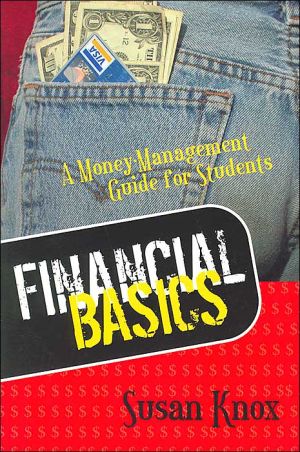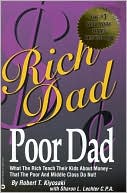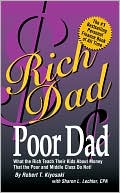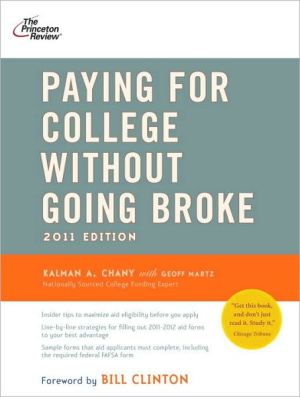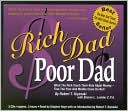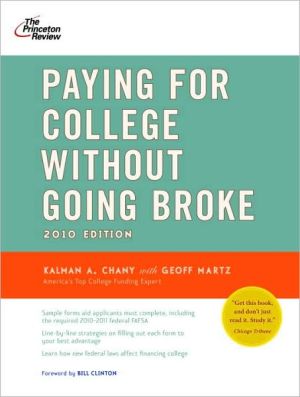Financial Basics: A Money-Management Guide for Students
"In Financial Basics, Knox blends her money-management experience with her desire to inform and help students master their finances: she shares experiences about money lessons learned in college, and offers sound solutions and advice for students and their families. Since everyone does not handle money in the same way, Knox gives money-management options for readers to find their best way." The book includes helpful worksheets and is written in an easy-to-read style, using testimonials and...
Search in google:
"In Financial Basics, Knox blends her money-management experience with her desire to inform and help students master their finances: she shares experiences about money lessons learned in college, and offers sound solutions and advice for students and their families. Since everyone does not handle money in the same way, Knox gives money-management options for readers to find their best way." The book includes helpful worksheets and is written in an easy-to-read style, using testimonials and examples that will ring true to students. Ed Goldberg - VOYA College is the first time that many teens control their own finances, and financial mismanagement at this critical period can have serious long-term ramifications. Financial planner and CPA Knox pounds into readers' heads such basics as reconciling bank accounts monthly, understanding repayment terms of loans, realizing that credit cards are debt and not cash, that budgeting is essential, and consulting a trusted adult or credit counselor when in doubt or trouble. Students must prioritize spending but realize that unexpected expenses always arise. The author illustrates how to write checks and reconcile bank accounts, activities that students might not know how to perform. Targeting college students and parents, chapters are short and the language is on a ninth-grade level. Personal stories beginning each chapter are effective, and author commentary adds and stresses important points. Chapter order, however, is haphazard. The funding college chapter is extremely weak, and the book glosses over important points, such as how credit worthiness is determined and tracked. There is a useful glossary, but highlighting those words within the text also would be helpful. The constant repetition of such statements as "reconcile bank accounts monthly" in multiple chapters gets monotonous. A less preachy book written by college students, Getting Through College Without Going Broke (Natavi Guides, 2003), is equally effective and written in an easygoing style. If forced to choose one book on this subject for a high school or public library, this reviewer would purchase the latter. VOYA CODES: 3Q 3P S (Readable without serious defects; Will appeal with pushing; Senior High, defined as grades 10 to 12).2004, Ohio State University Press, 145p.; Glossary. Index. Charts., and Trade pb. Ages 15 to 18.
1Seduced by credit cards2Nervous breakdown budget3First in the family4The simple things in life5Spend, spend, spend6How much did you say I owed?7But don't I need to build a credit history?8Car crazy9I'll think about it tomorrow10Now where did I put that?11What's next?12Develop a personal philosophy of money13Your story
\ VOYACollege is the first time that many teens control their own finances, and financial mismanagement at this critical period can have serious long-term ramifications. Financial planner and CPA Knox pounds into readers' heads such basics as reconciling bank accounts monthly, understanding repayment terms of loans, realizing that credit cards are debt and not cash, that budgeting is essential, and consulting a trusted adult or credit counselor when in doubt or trouble. Students must prioritize spending but realize that unexpected expenses always arise. The author illustrates how to write checks and reconcile bank accounts, activities that students might not know how to perform. Targeting college students and parents, chapters are short and the language is on a ninth-grade level. Personal stories beginning each chapter are effective, and author commentary adds and stresses important points. Chapter order, however, is haphazard. The funding college chapter is extremely weak, and the book glosses over important points, such as how credit worthiness is determined and tracked. There is a useful glossary, but highlighting those words within the text also would be helpful. The constant repetition of such statements as "reconcile bank accounts monthly" in multiple chapters gets monotonous. A less preachy book written by college students, Getting Through College Without Going Broke (Natavi Guides, 2003), is equally effective and written in an easygoing style. If forced to choose one book on this subject for a high school or public library, this reviewer would purchase the latter. VOYA CODES: 3Q 3P S (Readable without serious defects; Will appeal with pushing; Senior High, defined as grades 10 to 12).2004, Ohio State University Press, 145p.; Glossary. Index. Charts., and Trade pb. Ages 15 to 18. \ —Ed Goldberg\ \
